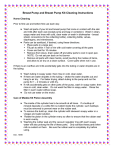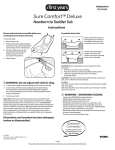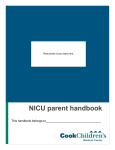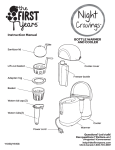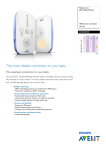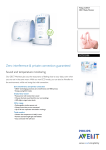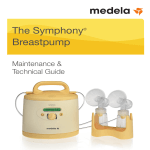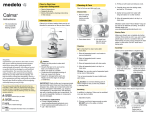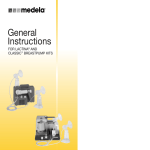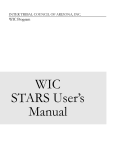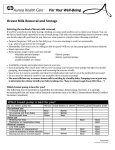Download Breast Pump Basics
Transcript
Breast Pumps Breast Pump Basics All you need to know about this life-saving gadget that makes breastfeeding manageable for working moms. BY BETH STARKEY B y now, most people know that breastfeeding has been associated with a wide number of benefits to both baby and mom. After all, who hasn’t heard the phrase “breast is best”? Benefits for baby include protection against many different illnesses and diseases. Long-term benefits include reduced risk for childhood and adult obesity, diabetes, and even childhood leukemia and lymphoma. Benefits to mom include faster healing after delivery, lower risk for postpartum depression, as well as decreased lifetime risks for diabetes, cardiovascular disease, rheumatoid arthritis, hypertension, and breast and ovarian cancer. To provide the most benefits to baby and mom, the American Academy of Pediatrics recommends babies be exclusively breastfed until six months, with continued breastfeeding until at least one year old or older as other foods are introduced. However, according to the U.S. Department of Health and Human Services, up to one third of working women do not take any maternity leave. Of those who do, the average maternity leave lasts a mere 10.3 weeks. Assuming most working moms don’t have the luxury of bringing baby to 78 Pregnancy / Buyer’s Guide 2014 Like us on work to feed on demand, that’s far short of the recommended six months. Enter the breast pumps. They not only collect milk without baby, but they can help stimulate and keep milk production up. There are many different types of pumps on the market, including manual, electric, single and dual. Manual pumps use human muscle power in either a piston style or trigger style manner. Each breast is pumped separately. Most manual pumps require both hands to use and can be tiring. As these pumps generally don’t empty breasts as well as their electric counterparts, manual pumps are facebook.com/pregnancymag and follow us on @pregnancymag Breast Pumps generally the pumps of choice for women who only need to pump occasionally. Electric pumps use modern technology to do the work for you. They are generally fully automated, can mimic baby’s sucking cycles, and are much more efficient. Most models allow for both breasts to be pumped at once, which significantly cuts down pumping times. Electric pumps are the pumps of choice for women needing to pump frequently (most working moms). Common parts include the pump itself, breastshields (the funnel-like piece that fits over the breast), a connector that attaches the breastshields to the bottle (named differently depending on the company, such as flanges and adapters), valves that attach to the bottom of the connector allowing milk to pass through into the bottle, and tubing to attach the pump motor to the connector. Most pumps will include at least a couple of bottles with nipples and bottle collars, samples of nipple cream, breast pads, and milk storage bags. Other gear may include coolers/ice packs, extra bottles, alternative sized breast shields, and hands-free pumping bras. Most pumps have multiple cycles and suctioning strengths. When breast feeding, babies stimulate milk flow with quick shallow sucks. After milk has letdown, feeding occurs with slower, stronger sucks. Some pumps emulate the early “let down” phase to help stimulate milk release. Additionally, adjustable cycle and suction allows mom to choose the strength to maximize milk collection while still maintaining comfort. Another important distinguishing feature is a closed versus open system. A closed system has a physical barrier that prevents milk or moisture from entering the tubing. This is not only important because moisture can destroy a pump, but bacteria and mildew can grow in the tubing and contaminate your milk. When using an open system pump, pay careful attention to ensure that moisture never gets into the pump. Additionally, manufacturers recommend that you run the pump with just the tubing attached to dry tubes to prevent mildew. Pumps will attach to standard or non-standard wider-neck bottles. Each brand offers its own nipple and bottle system for convenience. If you choose a different bottle system, make sure the size matches the pump. This allows you to pump directly into the bottles without having to transfer. Most pumps will not pump directly into freezer bags. Electric pumps are the pump of choice for working moms. PregnancyMagazine.com 79 Breast Pumps Lansinoh® Signature Pro ® Double Electric Breast Pump 80 The First Years miPump Double Electric MSRP: $149.99 MSRP: $70-$80 Weight 2.3 lbs, battery and AC adapter, no car adapter, 6 cycle speeds, 8 suction settings, standard bottle, closed system. Weight 2 lbs, battery/AC adapter, no car adapter, 8 cycle speeds / suction settings, non-standard bottle, open system. lansinoh.com thefirstyears.com The Signature Pro pump is flat with built-in bottle holders and timer. It is very lightweight, weighing in at about 2 pounds. A new design makes this pump as compact as other pumps and it will fit into larger purses or tote bags. An LCC timer helps you monitor time and gives you control over three customizable pumping styles. The breastshields are hard plastic with a softer plastic “cushion” for comfort. Additionally, because the system is closed, the connector body has a special diaphragm design which blocks moisture or milk from collecting into tubes. While this introduces another piece for cleaning, you never have to wash the tubing or dry the pump tubes (which saves considerable time and energy in the long run). The valves come in one piece, which also allows for easier cleaning. The connector piece fits standard bottle sizes, so you can pump directly into most bottles. The kit also contains a carry tote, two bottles, two storage bags, and two nursing pads. The Signature Pro is in the middle of the price range. It is easy and comfortable to use, and does an excellent job of expressing milk in a short period of time. The First Years pump is one of the smaller pumps, though if using batteries, it must be in its pump cradle. There is no let-down phase, and it is recommended that you hand express first to achieve let-down. It has up/ down buttons to control cycle/suction. The breastshields are soft plastic, which are comfortable but can flip inside-out with pressure. There is a handle attachment to allow for single-hand pumping. While it is an open system, milk rarely made its way into the tubing. However, because moisture still collects in the tubing, care is needed to keep it clean. The valve consists of two attached pieces, which makes cleaning a little difficult. The First Years pump is one of the cheaper pumps on the dual electric market. It does include a tote carrier, although it would likely not have space for extra bottles and cooler (which are not included). While comfort is not equal to other, more expensive pumps, the First Years miPump expresses milk very well and is a great alternative for mothers on a budget. Pregnancy / Buyer’s Guide 2014 Like us on facebook.com/pregnancymag and follow us on @pregnancymag Breast Pumps Medela Pump In Style Tote MSRP: $250-$300 Weight 1 lb (attached to tote), battery and AC adapter, car adapter available, let down, cycle/suction continuously variable, standard bottle, open system. medelabreastfeedingus.com The Medela pump is attached to the tote (or other carrying bag depending on model) with its own easy-access compartment. While this makes it very portable, it may be harder to actually move while pumping and will take up more space on a countertop or desk. It includes a let-down setting, with a button to switch from stimulation to expression phases (will otherwise automatically switch after two minutes). A single dial is used to control cycle/suction. The breastshields are hard plastic and fit well over the breast with a good seal. The valve consists of two separate parts, including a hard plastic piece and a removable membrane. Tote quality is very good with enough space to carry the cooler pack and other gear. However, as the tote is attached to the pump, you cannot repurpose it after your pumping days are over. As one of the more expensive personal pumps on the market, it includes many extras including a cooler with ice pack and four collecting bottles. Medela is the pump of choice for many hospitals. Medela Freestyle Breast Pump MSRP: $320-$350 Weight 1 lb, battery and AC adapter, car adapter available, let down, cycle/suction variable, standard bottle, open system. medelabreastfeedingus.com The Medela Freestyle pump is all about portability. The pump is small enough to fit in the palm of your hand and can be thrown into most bags or purses. Included rechargeable battery pack holds its charge for 3+ hours of pumping, which means you only have to recharge it once or twice a week depending on use. Rechargeable batteries also mean not spending extra money on batteries. The hands-free attachment allows a pumping mom to multi-task; however, the one provided with the Freestyle is a bit cumbersome to use. The Freestyle comes with two sizes of breastshields and both fit well over the nipple and easily create a good seal. Like other Medela pumps, there is both a let-down and an expression cycle—but beware, Medela pumps are strong! Start on a lower suction level and work your way up to maximum strength. The pump timer records your pump sessions so that you can track your pumping sessions and then return to your best pumping pattern. Freestyle works with all Medela accessories. However, the Freestyle comes with a steep price tag. If you can afford the price and need a pump that is portable, small and reliable, Freestyle is for you. PregnancyMagazine.com 81 Breast Pumps Philips AVENT Double Electric Comfort Breast Pump MSRP: $160-$220 Weight 1.3 lbs, AC adapter, no battery, no car adapter, cycle/suction continuously variable, non-standard bottles, closed system. avent.com Philips AVENT pump offers many unique features. First, rather than having dial/button controls for cycle/suction, the pump controls are on a special attachment that sits on one of the breast connectors. There is a trigger-like controller that allows you to establish the cycle/suction, with a memory button to instruct the pump to continue automatically. The pump will remember the last cycle, although you can “manually” pump with the trigger to adjust cycle/strength at any time. While this allows for a more customizable pump, it can take a while to get used to. The pump motor is large and has no battery option, making it less portable. However, it is much quieter than other brands. The breastshield is permanently attached to the connector, making use with a hands-free bra more challenging, though still possible. There is a special “let-down massage cushion” that fits inside the shield. This cushion helps mimic a baby’s natural suck, and improves let-down. It is a closed system, so no tube cleaning is required. The AVENT pump is designed to pump directly into the popular wide neck AVENT bottles. The pump comes in an attractive black tote with a cooler (no ice pack). While on the more expensive side, it is one of the most customizable and quiet pumps available. 82 Pregnancy / Buyer’s Guide 2014 Like us on The First Years Quiet Expressions Double Breast Pump MSRP: $99.99 2 lbs.; battery/AC adapter, no car adapter, 8 cycle speeds/suction speeds, non-standard bottle, open setting. thefirstyears.com The Quiet Expressions pump is a good choice in the lower price category, with features rivaling more expensive pumps such as battery and plug-in options, as well as eight adjustable suction settings. Included is a digital display with basic functions, but not the more extensive tracking available on other pumps. The unique handle allows one-hand operation which is certainly a benefit versus older machines, but you should weigh the value of having both hands free, especially if you can imagine yourself working while pumping. The flex-fit shields common to other First Years pumps are soft plastic, but can flip inside out under pressure. Like other First Year pumps, the Quiet Expressions also includes a tote carrier and two 4 oz. “GumDrop” bottles which feature slow flow nipples, but are not a standard size. The tote is bigger than previous bags, and comfortably fits the lightweight pump which weighs slightly less than most other choices. The major benefit of this pump is spelled out in its name; this is definitely a quieter pump than some we’ve seen at higher prices. The First Years Quiet Expressions is another good option for moms on a budget. facebook.com/pregnancymag and follow us on @pregnancymag Not All Breastpumps Are Created Equal. Medela’s Pump In Style® Advanced breastpump features patented 2-Phase Expression® technology, which is proven to get 18% more milk* when double pumping. Pump In Style has been supporting millions of moms for more than 15 years. Don’t settle for just any pump. Your Medela breastpump may be covered by insurance, so ask for the #1 Choice of breastfeeding moms. To find where you can get your Medela breastpump, visit findinsurancepumps.com. Keep the connection. *Compared to single pumping with 2-Phase Expression technology at maximum comfort vacuum Breast Pumps BREAST PUMPS checklist Not able to imagine what’s important in a breast pump? We can help with this list of features and benefits for the latest pumps. Breast pumps are indispensable, especially if you’re going back to work. 1. Types of Breast Pumps MANUAL BREAST PUMPS are good to use occasionally. They work by using a system of two cylinders to create suction. A manual pump 2. Questions to ask yourself How often do you plan on breastfeeding? Do you plan on breastfeeding can also help draw out inverted or flat nipples. exclusively or will baby’s meals be These pumps take the longest to use. supplemented with formula? How often will you need to use your SEMI-ELECTRIC BREAST PUMPS breast pump? Every once in a while or are battery-powered on a consistent schedule? pumps that use Are you considering a single pump a small motor to or double pump? creation suction for extracting milk. Are you a mom on the go? These are for moms What is the time frame that you who pump once or want to set aside to pump? twice a week. Most are small enough to carry in a purse and Do you have any budget restrictions? you control the rhythm of the pump. Extra batteries are strongly recommended Would you prefer to rent or buy your breast pump? for emergency situations. Will you be using your breast pump ELECTRIC just at home or do you need one that’s BREAST PUMPS easy to transport and pack? How lightweight are for moms who do you want your breast pump to be? need to pump at least twice daily. What about ease of assembly? They are a necessity for moms whose Will the breast pump be easy to baby temporarily clean and sterilize? cannot feed. They are durable and Are adjustable suction levels light-weight, come with a smooth operating something that is important to you? rhythm and make very little noise. They usually 84 come with a dial or a switch to control the level Is noise level a concern for you? of suction. Pumping takes about 10-15 mins and For moms who plan on pumping at work, some come with double pumping attachments. the noise factor may affect comfort level. Pregnancy / Buyer’s Guide 2014 Like us on facebook.com/pregnancymag and follow us on @pregnancymag Breast Pumps 3. Find the breast pump that’s best for your needs. Check the features you need most in a breast pump in the first column. Make any notes in the last columns to compare the model you are considering. FEATURE KEY TO ME PUMP __________ PUMP __________ PUMP __________ Glass bottle/ BPA-free plastic bottle: Plastics with BPA have been shown to have adverse effects on children. Look for BPA-free on the labeling or consider glass bottles. Plastic milk storage bags are generally not recommended for long-term storage. Suction settings: Many electric models have adjustable suction settings that mimic a baby’s natural nursing pattern. Warranty Adapter/ batteries Double pumping: Some models offer double pumping as well as alternating double pumping. Double pumping has also been shown to maintain more milk supply long-term. Carrying case Pump weight Noise level Breast shields: Some women may find it necessary to separately buy breast shields which better adapt to their shape. Pump type: For manual models especially, some pump types may be easier to use than others Hands-free operation PregnancyMagazine.com 85








